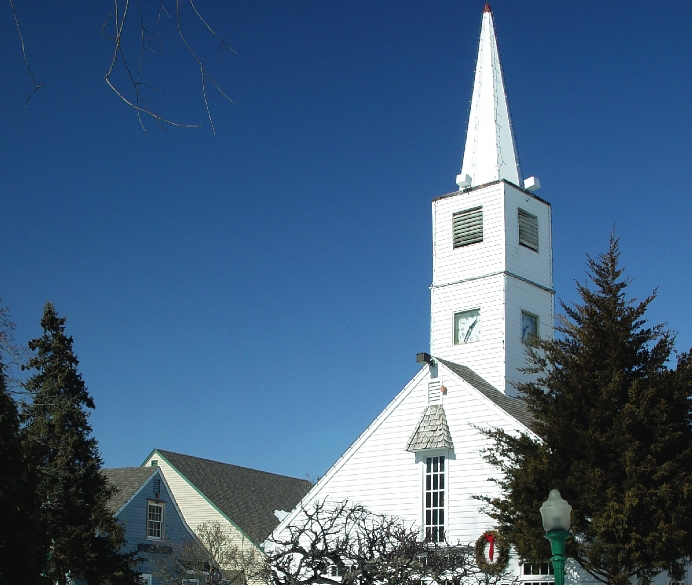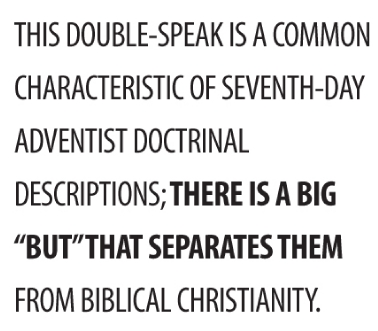
HOME / PROCLAMATION! MAGAZINE / 2014 / WINTER / ADVENTISM EXAMINED WITH RICK BARKER
W I N T E R • 2 0 1 4
VOLUME 15, ISSUE 4

Rick Barker is a native of Southwestern Ohio and facilitates a weekly Bible study for former and transitioning Adventists in the Dayton, Ohio, area. Rick graduated from Andrews University in 1987 and received a Masters degree from the University of Dayton. Rick and his wife Sheryl formally left the Adventist chuch in 2004. Prior to this they had been active in the Miamisburg and Wilmington, Ohio, churches.

D E P A R T M E N T S
Adventism EXAMINED with Rick Barker
Adventism's Fundamental Belief #12: The Church
The church is the community of believers who confess Jesus Christ as Lord and Savior. In continuity with the people of God in Old Testament times, we are called out from the world; and we join together for worship, for fellowship, for instruction in the Word, for the celebration of the Lord’s Supper, for service to all mankind, and for the worldwide proclamation of the gospel. The church derives its authority from Christ, who is the incarnate Word, and from the Scriptures, which are the written Word. The church is God’s family; adopted by Him as children, its members live on the basis of the new covenant. The church is the body of Christ, a community of faith of which Christ Himself is the Head. The church is the bride for whom Christ died that He might sanctify and cleanse her. At His return in triumph, He will present her to Himself a glorious church, the faithful of all the ages, the purchase of His blood, not having spot or wrinkle, but holy and without blemish.
While the Seventh-day Adventist (Adventist) Fundamental Beliefs splits the description of the doctrine of the church from the doctrine of the remnant church, these two teachings cannot be completely separated within Adventism, and we address them together in a single article.
As we have seen in many previous Fundamental Beliefs, this 12th Adventist doctrinal statement contains wording that would appear consistent with evangelical Christian teaching about the universal church. In fact, I found its wording so convincing that when I initially reviewed the Fundamental Belief statements, I didn’t look at the book Seventh-day Adventists Believe to read the official commentary on the belief. Instead I simply concluded that this belief statement accurately presents the biblical concept of the universal church. Unfortunately, however, Fundamental Belief #12 is completely negated by Fundamental Belief #13 regarding the “remnant church”.
The incongruence between a universal church of all believers and a remnant (Adventist) church should be apparent no matter the amount of Adventist double-speak on the subject. I was a little surprised, however, how plainly Seventh-day Adventists Believe explained the Adventist code words for us:
Just so today, He intends to lead His people into His visible church, characterized by loyalty to God’s commandments and possessing the faith of Jesus, so they may participate in finishing His mission on earth (Rev. 14:12; 18:4; Matt. 24:14; see chapter 13 of this book).1
Everyone familiar with Adventism knows what specific “visible church” the passage is describing with the familiar phrasing of Rev 14:12—loyalty to God’s commandments (or “keeping the commandments of God”) and possessing (having) the faith of Jesus. These words, quoted from chapter 12 of Seventh-day Adventists Believe, are describing the same church as that which is explained in chapter 13, “The Remnant And Its Mission”: the Seventh-day Adventist Church.
When we understand that Adventists have defined the “visible church” as their own church organization, their definition of the invisible or universal church begins to become clear:
The invisible church, also called the church universal, is composed of all God’s people throughout the world. It includes the believers within the visible church as well as many who, although they do not belong to a church organization, have followed all the light Christ has given them (Jn. 1:9). This latter group includes those who have never had the opportunity to learn the truth about Jesus Christ but who have responded to the Holy Spirit and “by nature do the things contained in the law” of God (Rom. 2:14).2
In other words, according to Adventists the universal church consists of Adventists (visible church) and many who do not belong to a church organization. It even consists of those who have never heard of, or learned about, Christ. Instead of salvation only being available through faith alone in Christ, according to this Fundamental Belief, a person can be counted by God as being one of His people simply by doing good things.
There is no mention here or anywhere within the chapter of people in other churches also being part of the universal church. In contrast, a typical, mainstream Christian expression of the universal church would be similar to this explanation:
At the same time, all believers are members of the universal church. The universal church is made up of every single person who has exercised faith in Jesus Christ for salvation, including members of every local church body throughout the earth (1 Cor. 12:13; Eph. 1:22-23).3
Adventism’s Fundamental Belief #13: The Remnant and Its Mission
The universal church is composed of all who truly believe in Christ, but in the last days, a time of widespread apostasy, a remnant has been called out to keep the commandments of God and the faith of Jesus. This remnant announces the arrival of the judgment hour, proclaims salvation through Christ, and heralds the approach of His second advent. This proclamation is symbolized by the three angels of Revelation 14; it coincides with the work of judgment in heaven and results in a work of repentance and reform on earth. Every believer is called to have a personal part in this worldwide witness.
 Once again, the casual reader who is unfamiliar with Adventism isn’t likely to grasp all that is meant by this statement. There are meanings buried beneath this belief statement that are explained in Adventist literature to which the average Christian would have little access; therefore, the real meaning of this fundamental belief would be unlikely to be examined by the Evangelical Christian community. While Adventists have invented many fancy dodges to the question, “What is the remnant church?”, the simple truth is that the official teaching of Adventism is that the Remnant Church is, both historically and currently, the Seventh-day Adventist Church.
Once again, the casual reader who is unfamiliar with Adventism isn’t likely to grasp all that is meant by this statement. There are meanings buried beneath this belief statement that are explained in Adventist literature to which the average Christian would have little access; therefore, the real meaning of this fundamental belief would be unlikely to be examined by the Evangelical Christian community. While Adventists have invented many fancy dodges to the question, “What is the remnant church?”, the simple truth is that the official teaching of Adventism is that the Remnant Church is, both historically and currently, the Seventh-day Adventist Church.
The baptismal vows in the official Adventist church manual confirm this internal understanding:
13. Do you accept and believe that the Seventh-day Adventist Church is the remnant church of Bible prophecy and that people of every nation, race, and language are invited and accepted into its fellowship? Do you desire to be a member of this local congregation of the world church?4
Also from the Seventh-day Adventist church manual:
28. In accordance with God’s uniform dealing with mankind, warning them of coming events that will vitally affect their destiny, He has sent forth a proclamation of the approaching return of Christ. This preparatory message is symbolized by the three angels’ messages of Revelation 14, and meets its fulfillment in the great Second Advent Movement today. This has brought forth the remnant, or Seventh-day Adventist Church, keeping the commandments of God and the faith of Jesus. (Amos 3:7; Matt. 24:29-34; Rev. 14:6-10; Zeph. 3:13; Micah 4:7, 8; Rev. 14:12; Isa. 26:2; Rev. 22:14.)5
Fundamental Belief #13 begins with truth: “The universal church is composed of all who truly believe in Christ,” and then it inserts a qualifier that negates this truth, “but in the last days”. This double-speak is a common characteristic of Seventh-day Adventist doctrinal descriptions; there is a big “but” that separates them from biblical Christianity. In reality, there is no such thing as a remnant church that is unique and distinguished from the universal church.
Rev. 14:17 says, “So the dragon was enraged with the woman, and went off to make war with the rest (remnant) of her children, who keep the commandments of God and hold to the testimony of Jesus.”
This symbolic woman first gave birth to Jesus, and He is the only child of this woman mentioned in the chapter. The rest (or remnant) of her children are all of the adopted children of God. For the Adventist church to claim to be the rest of her children is a direct denial of the universal church.
Furthermore, according to Scripture it is not this remnant who announce the judgment hour, but an angel. Nothing in the scriptural passage of Revelation 14 suggests that these angels are symbolic of a church. Interestingly, Seventh-day Adventists do not consider any other angels in the book of Revelation to be symbolic of a church. In fact, nothing links these angels to the remnant, nor is there anything in Revelation 14 indicating the believers are called to join the angels in making this proclamation. The idea, therefore, that “Every believer is called to have a personal part in this worldwide witness” is not supported by the passage.
The notion that the proclamation of this message corresponds to a work of judgment going on in heaven is yet another extra-biblical insertion into the belief statement. The proclamation in Revelation 14 is that judgment has come, not that it is in the process of taking place in heaven. Moreover, the language used by the angels in Revelation 14 is the same as the language used in chapter 18. The sole reason that Adventists link Revelation 14:7 with the idea of a judgment that is in the process of taking place in heaven is that they use this passage to validate their investigative judgment doctrine. This idea, however, is simply not found in the words of the passage. Moreover, the judgment in Revelation 14:7 is a judgment of the wicked. The investigative judgment of Adventism is a judgment of professed believers.
In summary, this fundamental belief is not founded on sola scriptura. Adventists have skewed the meanings of the words of the Bible to validate their unique, unbiblical doctrines. Consequently, Fundamental Belief #13 clarifies the underlying Adventist meaning of Fundamental Belief #12. Taken together, these belief statements reveal many extra-biblical ideas that are camouflaged by “evangelical wording” but which actually describe unique doctrines that are completely unsupported by the biblical passages they cite.
Endnotes
- Seventh-day Adventists Believe, 2005, Pacific Press Pub. Assoc., P. 171, par. 5.
- Ibid., par. 3
- http://christianity.about.com/od/churchandcommunity/a/thechurch.htm
- http://documents.adventistarchives.org/Resources/ChurchManuals/CM2005__D.pdf
- Ibid.

Copyright 2015 Life Assurance Ministries, Inc., Camp Verde, Arizona, USA. All rights reserved. Revised January 3, 2015. Contact email: proclamation@gmail.com
ADVENTISM'S FUNDAMENTAL BELIEF #12:
THE CHURCH
ADVENTISM'S FUNDAMENTAL BELIEF #13:
THE REMNANT AND ITS MISSION
WHAT IS THE
CHURCH?